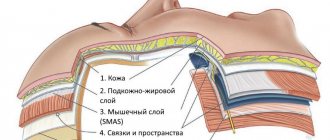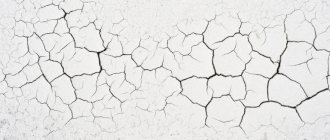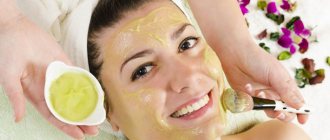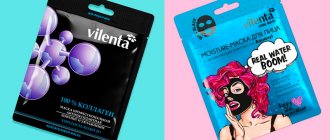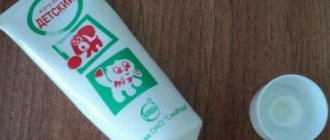Facial skin types and their characteristics ↑
Of course, our skin is complex, and it won't always fit into a certain box. There are many factors that can influence and change the condition of the epidermis, but the following guide will help you better understand the overall behavior of your skin.
This, in turn, will give you the opportunity to choose the best products and methods for caring for your face. In modern cosmetology, there are no longer 4 types of facial skin, but 5 - to the classic characteristic, a combined skin type has been added, which combines two others at the same time.
Structure of facial skin: photo
Take the online tests below and see which one is most similar to your skin!
How to understand facial skin type by its texture ↑
Pay attention to how your skin usually feels. It is important to notice how it feels on any day of the week - usually a certain type is established in youth and does not change throughout life (because if the skin suddenly begins to shine unusually or, on the contrary, looks dry, although I have always been oily - you need to change your skincare products). The texture of our skin can also tell us a lot about our skin type - that's what we'll do.
Combination skin ↑
Combination skin usually feels very oily only in the T-zone (the area that includes your forehead, nose and chin), but dry elsewhere (especially the cheeks). It can also be oily and dry in different places, but if you notice two completely opposite textures on your face, that's a sign that you're dealing with combination skin!
Sensitive skin ↑
Sensitive facial skin usually looks uneven, may become covered with red itchy spots, and becomes inflamed quickly. It does not tolerate many cosmetic products well and causes its owner a lot of trouble.
Normal skin ↑
Normal skin appears even and balanced. It's not too dry or too oily, rarely sensitive, and overall looks healthy and smooth.
Oily skin ↑
Oily skin feels oily to the touch and gets dirty very quickly. If you feel that your face is constantly shiny and glossy, and needs mattifying products and powder, then your skin is almost certainly oily.
Dry skin ↑
Dry skin feels rough and even hard to the touch. In winter, this type of skin suffers especially - cracks may even appear on the face.
What are the different skin types?
Fortunately, experts have long given a clear answer to the question “How many skin types are there?” - four. These include normal skin, dry, oily and combination skin. Some cosmetologists also include sensitive skin in this classification - however, this is not entirely correct. Sensitive (that is, acutely reacting to external factors) skin of any type can be - this is rather a temporary characteristic.
Now that you know how to determine your skin type at home, we will tell you how to choose the right cosmetics for each type.
Dry skin
This skin type is prone to deficiencies (underreplenishment) of lipids, which help prevent moisture from evaporating from the skin layers. This causes the skin to appear thin, “parchment-like” or “porcelain-like” (depending on skin tone), as if dehydrated. It is very important to choose nourishing and deeply moisturizing products for dry skin that have the ability to “seal” and retain moisture inside the cells for a long time.
Among VICHY products there are entire series that are produced separately for dry, and separately for normal/combination skin. When choosing cosmetics to solve certain problems, take those that contain the mark “for dry skin” - they are most adapted to the characteristics of this skin type and to its protection.
Good example:
- Moisturizing rich cream Aqualia Thermal , which contains a special “isotonic cocktail” - a powerful combination of ingredients that deeply nourishes and moisturizes the skin from the inside, helps retain moisture and regenerate the skin.
AQUALIA THERMAL
Moisturizing rich cream for dry to very dry skin
The first range containing a moisturizing “isotonic cocktail” to restore the water-mineral balance of the skin.
1587 rub. buy
Oily and problematic skin
Unfortunately, skin prone to oiliness and inflammation is usually immediately visible. High shine, enlarged pores, blackheads... Such skin needs not only regular deep cleansing, but also (which many people don’t realize) constant hydration, which helps curb excess sebum production.
Good example:
- The Normaderm line from VICHY, which contains carefully selected acids to eliminate imperfections in problem skin, antioxidants to restore, smooth and protect the skin, as well as moisturizing and gentle cleansing components that protect the skin from excessive drying.
- Purifying clay mask from VICHY, which contains two types of clay for deep cleansing of pores and allantoin and aloe vera to restore water balance and properly moisturize the skin.
MINERAL MASK
Pore-refining clay mask
Deeply cleanses the skin, softens and restores mineral balance.
1688 rub. buy
Combination skin
Such skin can simultaneously give unwanted shine and inflammation in the T-zone and at the same time peel off on the cheeks or temples. Your task: to select cosmetics for combination skin, and if it is highly sensitive, to look for the optimal products for each specific area of the face.
It should be taken into account that both special products for combination skin and fairly universal ones may be suitable for you - if they solve your problems and, of course, do not cause unwanted reactions in any individual areas of the face.
Good example:
- Daily gel serum MINERAL 89 – for sensitive skin (including combination skin) susceptible to aggressive external influences. A high concentration of hyaluronic acid in combination with VICHY thermal water helps strengthen and tone the skin, as well as activate and enhance its own protective functions.
MINERAL 89
Daily gel-serum for skin exposed to aggressive external influences, 30 ml
The first gel serum with a record concentration of VICHY Mineralizing Thermal Water [89%] and naturally occurring Hyaluronic Acid in high concentration.
957 rub. buy
How to recognize facial skin type by the appearance of pores ↑
Our facial pores can also indicate a certain type and help us decide on it, since different skin types have different pores that look different and are of different sizes. The speed of pore clogging will also play an important role here.
1. Combination skin: If the pores are large and often clogged, inflamed around the nose, but small and unnoticeable on the cheeks and other areas of the face, this is a sign of combination skin.
2. Sensitive Skin: Ladies with this type of skin often have normal to large pores. Often, after using inappropriate cosmetics, inflammation may appear, the pores become red and even itchy.
3. Normal Skin: Women with this skin type usually have almost invisible pores.
4. Oily Skin: Girls with oily skin often struggle with large pores, which get clogged easily from sweat and oil secreted by the glands. Often, the pores on the nose and T-zone change color to dark - this means that there is excess dirt and sebum in them.
5. Dry Skin: Ladies with dry skin usually have small pores that can barely be seen. They rarely become clogged or inflamed.
How to check your facial skin type: washing method ↑
Pay attention to how your skin feels after hygiene procedures and morning washing with soap. This is usually the best way to determine what type you have. 1. After thorough cleansing, combination skin in the T-zone area looks refreshed and clean; it will feel especially comfortable after washing around the nose, where there is often excess oil. However, in the cheek area, combination skin becomes dry and may even become very flaky. 2. After washing, sensitive skin temporarily calms down and looks fresher than before washing. However, soon after cleansing, irritation and redness appear, and sometimes itching. It is also often difficult for such skin to choose cosmetics for washing - most products cause discomfort and flaking.
3. Women with normal skin feel their face clean and fresh after washing their face. Sometimes there is not enough moisturizing and cream, but for the most part the face does not look tight or shiny. 4. After cleansing, oily skin looks unusually matte, clean and lacks an oily sheen - this is the only time when the face does not shine, but soon after washing the skin becomes oily again. 5. For dry skin, washing with soap is real torture. Immediately after cleansing, the face noticeably tightens, the woman feels severe discomfort and the desire to moisturize the skin with a rich cream. Some areas may even crack due to dehydration, causing a burning sensation.
Care for combination skin
Combination skin causes a lot of trouble - it is both oily and dry at the same time. Such skin is characterized by the appearance of an oily sheen in the forehead, nose and chin and dryness on the cheeks. Caring for combination skin is not that easy—you need products that contain ingredients for both oily and dry skin, or you may have to buy two products for both skin types.
Cleansers should not contain alcohol, as it is harmful to both dry and oily skin. A kefir mask is very useful; it normalizes the acid balance of combination skin. Scrubs can be used no more than 3 times a week; they should not contain alcohol or strong abrasives.
What are your beauty secrets? Share with us in the comments!
How to determine your facial skin type by your day cream ↑
Consider how often you need moisturizer. Almost every one of us needs such a product to keep our skin healthy and hydrated. However, how often you use a cream can directly indicate how well your face stays hydrated on its own, and what type of skin you're dealing with. 1. Women with combination skin often need to apply moisturizer to some areas of the face that look dry (usually the cheeks), but rarely need it on other oilier areas (like the T-zone). 2. Sensitive skin usually requires a moisturizer several times a day, but it is difficult to find one that does not irritate it or cause an allergic reaction.
3. Women with normal skin do not have to apply moisturizer very often during the day, as the skin remains sufficiently hydrated on its own. Usually, simple care after washing your face in the morning is enough. 4. For girls with oily skin, moisturizer often acts as an enemy - it makes the face even more shiny and shiny, causes inflammation and worsens acne. Often, oily skin does not need a moisturizer. 5. Dry skin requires a lot of nourishing product throughout the day, and this is especially necessary after waking up and after each cleansing of the face.
What care does each skin type need ↑
Now that you have passed the facial skin type test and managed to recognize yours, you have a general idea of your dermis structure and its needs. We offer a short guide for each category that will allow you to get rid of many cosmetic problems and make friends with your own skin!
Combined skin type ↑
Although most of us have combination skin to some degree, since around our nose we have the most sebaceous glands (pores that produce sebum) than other areas of our face, combination skin types experience this to a greater extent. If you have this particular dermis structure, then your skin is characterized by a constantly oily and shiny T-zone with simultaneous dryness in other areas of the face. How to care for it: This is the most common type of dermis, and women with combination skin should use cosmetics from different categories for different areas of the face to maintain the balance of the dermis. For example, you can use a gentle cleanser and moisturizer on your cheeks and a harsher product on your T-zone to get rid of excess oil.
Sensitive skin type ↑
Many girls mistakenly believe that they have sensitive skin. After one or two bad reactions to a cosmetic product, this phenomenon is not uncommon, and it in no way characterizes sensitive skin behavior, it happens to everyone. It may be that the product simply wasn't a good choice and wasn't suitable for your skin or contained irritating ingredients. Truly sensitive skin is easily irritated even by the safest and non-allergenic cosmetics, such as baby milk and baby cream. Against this background, a rash often flares up and develops, and red spots appear. Women with sensitive skin may experience itching, sometimes swelling and a burning sensation in the affected area. In this case, your skin also becomes red and inflamed from gusts of wind, after washing or exposure to the sun. How to care: This is the most delicate skin type that needs constant care. Find a skin care routine that suits you, making sure to try samples before purchasing and testing them in the area of your face where your skin is most sensitive. This will allow you to determine which products worsen the condition of the dermis, and which ones restore calm to it. Look for products that are mild and gentle, without fragrances or harmful or harsh ingredients such as alcohol and menthol. Avoid scrubs that contain crushed walnuts, pumice, or aluminum oxide crystals. Use only warm water to wash your face - do not cleanse your face with hot or very cold water. It is strictly forbidden to wash your face with soap!
Normal skin type ↑
Normal skin is not too dry or oily - it does not cause much trouble and is the easiest to care for. If your skin is normal, it usually has an even tone and a soft texture with small pores. In hot weather, the T-zone (the central area of your face, including your chin, nose and the part of your forehead above your eyebrows) can sometimes become shiny and shiny, but in general this area is not oily to the touch. How to care for normal skin: Light lotions and serums are ideal for your skin type because you don't need a lot of oily and heavy products to keep your epidermis balanced and healthy.
Oily skin type ↑
Women with oily skin tend to have large pores and a shiny, uneven complexion. Your skin produces more than enough sebum, so hydration is not your problem. Rather, acne and pimples are the main scourge of this skin type. If you are still not sure if you have oily skin, then pat your face with a clean, dry cloth, and if there are oily spots on it, then most likely your skin is of this type. How to care for it: It is recommended to cleanse your face and avoid heavy, nourishing creams and emollients to minimize the work of the sebaceous glands. Look for oil-free sunscreens and lotions so you don't accidentally make your face look even more shiny and shiny.
Korean skin care system
Koreans have gone the furthest in matters of facial skin care, turning this action into a real ritual. There are 10 steps of care in the classical Korean system:
- Makeup removal with hydrophilic oil;
- Foam or gel for washing;
- Facial scrub or peeling;
- Toner, tonic or lotion;
- Essence or starter;
- Serum;
- Care in ampoules;
- Emulsion;
- Eye and face cream;
- Mask for the face.
This skincare marathon must be repeated morning and evening and under no circumstances should you skip any of the steps. Korean cosmetics have a very targeted effect, so daytime moisturizer only works in combination with toner, essence, and the list goes on.
What it is - a marketing ploy or a really working care scheme - can only be verified through personal experience. Koreans claim that this is the only way to achieve perfect skin. And some dermatologists say that over-care weakens the protective functions of the skin and makes it more sensitive and vulnerable to the environment.
How to care for your facial skin. Photo: depositphotos.com


